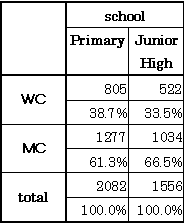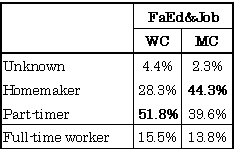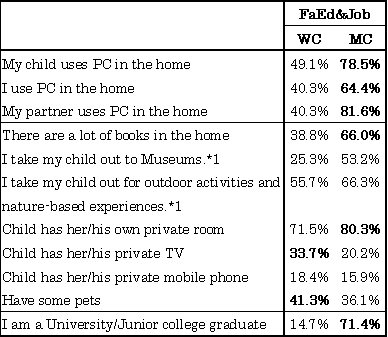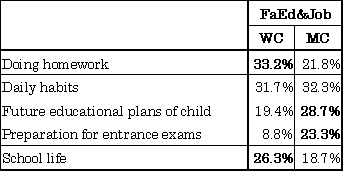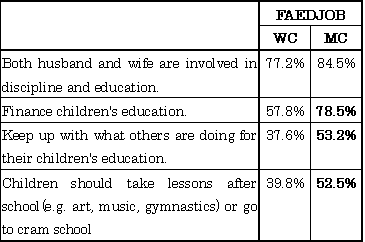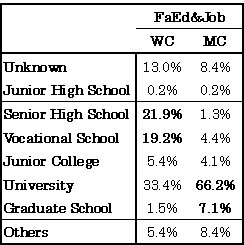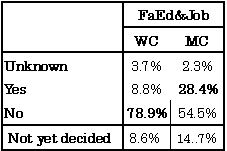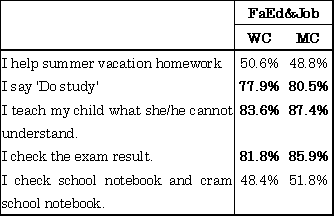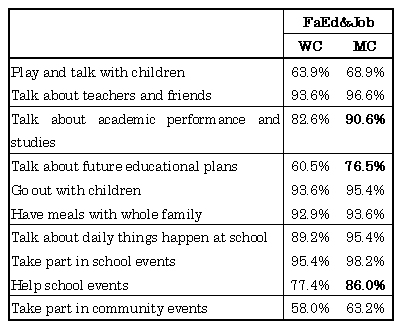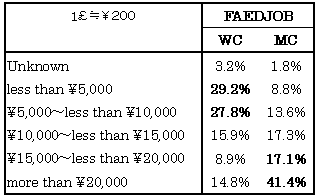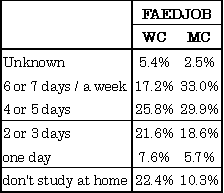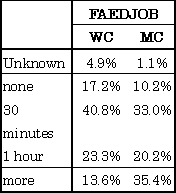| 1. Purpose I examined the relation between family backgrounds - such as parental occupations and academic careers and mother's educational expectation, educational choice, daily relationship to the children and their study. Japan is now on the edge of becoming a class society. Until recently, almost all Japanese believed that there was only one class and opportunities were meritocratically distributed. Or at least, they wanted to believe so. With regard to schools, Japanese educational system had been believed to be meritocratic. *Due to this reason, it used to be a taboo to conduct research on social classes in Japan. For instance, many schools would refuse questionnaire research which contained questions concerning students' family backgrounds. However, with changes in the economic and social conditions and the emergence of winners and losers, we Japanese have gradually come to realise and admit that we are indeed divided. In the case of education, as academic standards declined and the number of children refusing to go to schools (i.e. school phobia) increased in state schools, the myth that "state schools are good and worth going" has come to a finish. The myth of "equality of opportunity" has also become questionable. As the new policy allowing parental choice in the selection of schools for their children has just started only in a few restricted areas, while Japanese children with good family background can afford and choose to go to good private schools, their poorer peers have no choice but to attend local state schools even if they want good education. Nowadays, rich parents and well-educated parents have become sceptical about the legitimacy, relevancy and effectiveness of state schools. They now prefer private schools to state schools. Private schools, especially private junior high schools in Japan, pride themselves on their academic excellence and good discipline. On the other hand, state schools, which are losing their well-disciplined and academic-oriented Middle Class students, became disreputable. What is important here is that parents and children are not only sceptical about state schools but are also sceptical about formal schools! Middle Class families are aware of the usefulness of their children's schooling but make much of Juku (cram schools) rather than formal schools. For example, after successfully being admitted to a competitive private junior high school or private high school, many Middle Class families would send their children to Juku, once or twice and sometimes even three times a week in the evening. As Juku usually lasts two or three hours in a session, these children would be so tired that they normally fall asleep during boring day lessons. According to my son who is a student of a very competitive and snob private school, there are times when only 10% of the students in his class are awake, 80% asleep and the other 10% away. Similarly, Working Class families do not expect much benefit from attending state schools or attaining 'academic' qualifications. We can thus say to some extent that both Middle Class and Working Class families are trying to find 'benefits' outside the schools. While there are indeed many 'benefits' (or opportunities) outside the schools, Middle Class families tend to be at an advantage in giving good education to their children. Japan is now on the edge of falling into a class society and schools are increasingly becoming the apparatus for social reproduction. |
| 2. About Our Research This report reanalyses a questionnaire that was distributed in September 2002 to 6,085 parents of children in the first through ninth grades within the Tokyo metropolitan area. The research is called The Third Basic Survey on Child Rearing and I was one of the research team members. The Benesse Advanced Education Research Centre, Tokyo-Japan, who conducted the research, published the original report, which was unfortunately written in Japanese, in April 2003. |
| 3. Methodology Survey Topics:
Subjects: Parents of children in the first through ninth grades (6-15) Survey Regions: Tokyo, Saitama, Chiba, and Kanagawa Survey Method: Distribution of questionnaires at schools Sample: Number distributed: 9,038 (in 24 schools). Responses: 6,085(67.3%). Sample analysed today: 695 ( "Middle Class" and "Working Class" mothers of 5th and 6th grades) |
| 4. Definition and our sample Although the survey originally covered parents (mothers) who have children in the first through ninth grades, the focus of this paper will be on "Middle Class" and "Working Class" mothers of children in the fifth and sixth grades. In this paper, "Middle Class" (MC) mothers refer to wives whose partners are graduates of higher education institutions (Universities or Junior Colleges) and are white-collar workers. "Working Class" (WC) mothers refer to wives whose partners do not possess higher education qualifications and are non white-collar workers. Table 1 shows the distribution of MC and WC mothers with children in the first through ninth grades. |
||
Table 1. Father Job & Father Education (FaEd&Job)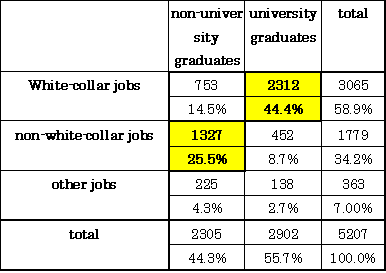 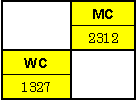 |
||
| white-collar jobs: Professional, Company director, Lecturer/Teacher, Factory supervisor/Line Managers non-white-collar jobs: Agriculturist, Owner of small businesses, Services/Sales worker, Skilled worker, Semi-skilled worker/Unskilled worker other jobs: Homemaker, Retired/Unemployed, Others |
||
|
||
| In order to avoid age bias, only mothers of children in Year 5 and 6 were selected. The reason for this is that while nearly all children in Japan go to state primary schools, a third of junior high school students, which starts from Year 7, are private in the inner Metropolitan area. Thus, parental opinion is expected to be strongest and clearest at Year 5 and Year 6. Based on this, 695 mothers were finally selected (279 WC mothers and 416 MC mothers) (see Table 3). |
||
Table 3. Children's Grade and Our sample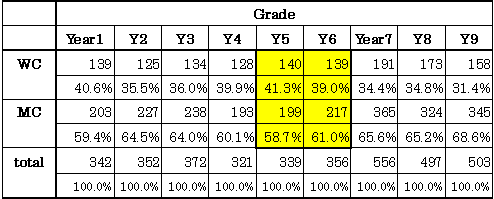 
|
| 5. Social and family difference between "Middle Class" mothers and "Working Class" mothers (Basic Attributes) 1. Mother's working status |
||
|
||
| 2. Family circumstances |
||
|
| 6. Concern and Consciousness 1. Current concerns |
||
|
||
2. Parents' educational policy |
||
|
||
3. Views on academic performance |
||
|
There are great differences among mothers' views on academic performance. Traditionally, we Japanese have wanted to make rapid advances to compete with the world, and in order to do so we made much of academic qualification rather than ability. Now, 70.0% of WC mothers think that they are "satisfied with children's academic performance if it is good enough to lead a normal life in the future" and about half of them "Do not care about child's academic performance if she/he enjoys school" . However, about half of them think that "Vocational qualification is more beneficial than academic career" . In a word, compared with MC mothers, WC mothers tend to attach more importance to vocational qualifications than academic qualifications. On the contrary, MC mothers tend to answer that academic performance "Should be as good as possible to enter competitive university" "It is essential to go to cram school for entering good school" and that they "want to know their child's weak point in learning" . Compared with WC mothers, MC mothers make much of academic qualifications and want to look after their children's learning. |
||
Table 8 How mothers view academic performance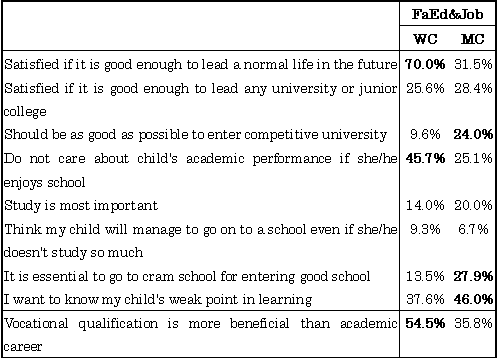 % of mothers answering "yes" |
||
3. The highest level of education expected |
||
|
||
4. Private Junior High School |
||
|
||
| About 30% of MC mothers plan to let their children go to private junior high school and about 15% have not yet decided. Conversely, only 9% of WC mothers plan to let their children take private junior high School entrance exam, 9% of them have not yet decided and about 80% do not plan to let their children sit for exam. To prepare for private junior high school entrance exam, children must start to study hard from the end of Year 3. At year 6, they usually have to study four times a week at cram schools. These cram schools open after day schools (formal schools) and normally last three to four hours until 9pm each day. However, what is important here is that children like cram schools more than formal schools because learning at cram schools is more interesting and exciting. For them, learning at day schools is boring, and the standard and discipline there are also miserable. |
| 7. Actual child rearing 1. Mother's encouragement to study |
||
|
||
2. Mother's frequent interactions with children |
||
|
| 8. Student performance 1. Juku (cram school) and private lesson |
||
|
||
2. Monthly average education expense |
||
|
||
3. Study days per week |
||
|
||
4. Study hours per day |
||
|
| 9. Discussion Schools in Japan have not been successful in responding to rapid social changes, such as short-sighted capitalism, diversification of the society, and the rise of consumerism, etc. Having lost the traditional functions of socialisation and social distribution, schools have become ineffective in controlling social mobility. Both Working Class and Middle Class families equally treasure education and they actually care a lot regarding their children's education. (Table 11,12) While both Working Class and Middle Class families do not fully rely on schools, the reasons behind this are quite different. For Working Class families, schools seem to be offering too much, whereas for the Middle Class families, schools just seem not to be sufficient. Working Class families hold vocational qualifications, which cannot be acquired through formal education, in high esteem. On the other hand, Middle Class families still value "academic qualifications (school career)" . (Table7, 8, 9,10) These differences among parents in educational consciousness and educational behaviour create inequality in education and cause Japanese education as well as the Japanese to be divided. (Table 13, 14, 15, 16) |



